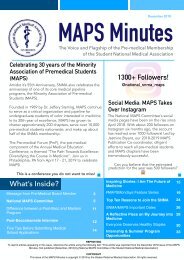JSNMA SUMMER 2019 Sneak Preview
You also want an ePaper? Increase the reach of your titles
YUMPU automatically turns print PDFs into web optimized ePapers that Google loves.
60 Commentary<br />
A<br />
2002 study published in<br />
Health Affairs – a journal of<br />
public health policy, thought,<br />
and research – identified<br />
that healthcare only plays a 10%<br />
role in premature death, while 60%<br />
is comprised of the following manmade<br />
factors: behavioral patterns<br />
(40%), social circumstances (15%),<br />
and environmental exposures (5%).<br />
The remaining 30% is due to genetic<br />
predisposition. 1 This is a humbling<br />
study for a physician because it<br />
makes him or her aware that their<br />
delivery of healthcare only plays a<br />
small part in the overall health of a<br />
patient. It is that patient’s behaviors<br />
and the community he or she lives<br />
in that play the largest roles in a<br />
patient’s survivability and mortality.<br />
In 2016, a study which assessed<br />
the association between income<br />
and life expectancy in the United<br />
States found, unsurprisingly,<br />
that life expectancy increases<br />
incrementally with income. More<br />
interestingly, however, was the<br />
J o u r n a l o f t h e S t u d e n t N a t i o n a l M e d i c a l A s s o c i a t i o n<br />
THE INTERSECTION<br />
BETWEEN COMMUNITY<br />
AND HEALTH<br />
LAMAR K. JOHNSON, MD<br />
PGY5 MEDICINE-PEDIATRICS RESIDENT AND CHIEF RESIDENT<br />
WAYNE STATE UNIVERSITY SCHOOL OF MEDICINE<br />
DETROIT MEDICAL CENTER PROGRAM<br />
great variation in life expectancy<br />
across geographic areas, which<br />
the study attributed to differences in<br />
health behaviors such as smoking,<br />
obesity, and exercise. The study<br />
also showed that individuals of the<br />
lowest income percentiles who lived<br />
in areas with higher overall levels<br />
of education and wealth, like New<br />
York City and San Francisco, lived<br />
approximately five years longer<br />
than those of comparable income<br />
percentiles living in less affluent<br />
communities, such as Detroit. The<br />
more affluent communities were<br />
also found to have higher immigrant<br />
...healthcare only plays a 10% role in premature<br />
death…[physicians] only play a small part in<br />
the overall health of a patient...behaviors and<br />
the community...play the largest roles…<br />
populations, higher home prices,<br />
and more college graduates. 2<br />
Together, these findings highlight<br />
the direct effect that a community<br />
can have upon health.<br />
Despite the aforementioned<br />
statistics, population health and<br />
disease prevention have been a low<br />
priority with expenditures for public<br />
health only accounting for 3% of<br />
the total spending on healthcare. 3<br />
This is a problem now, more than<br />
ever, as younger people currently<br />
have an increasing prevalence<br />
of non-communicable diseases<br />
(e.g. hypertension, diabetes, and<br />
cardiovascular disease), which were<br />
previously associated primarily with<br />
middle age and lifestyle factors .4<br />
Necessary Changes<br />
What must be done to improve the<br />
health of a community involves<br />
change at multiple levels. At the<br />
national level, public health policies<br />
must be enacted. They should<br />
focus upstream on the regulation of<br />
the food supply and food chain<br />
both nationally and locally, as<br />
well as on the food choices or<br />
the lack thereof. These policies<br />
are vital because evidence<br />
shows that while people may<br />
have the knowledge of how to<br />
eat healthily, they often lack<br />
the necessary resources to put<br />
their intentions into action. 4<br />
Other governmental agencies that<br />
could positively affect community<br />
health include the Department of<br />
Parks and Recreation as well as<br />
Law Enforcement. Per the former,<br />
prioritizing “place-making” can help<br />
create urban parks and spaces<br />
where people can and want to<br />
exercise and be active. By fostering<br />
safer neighborhoods, the latter






